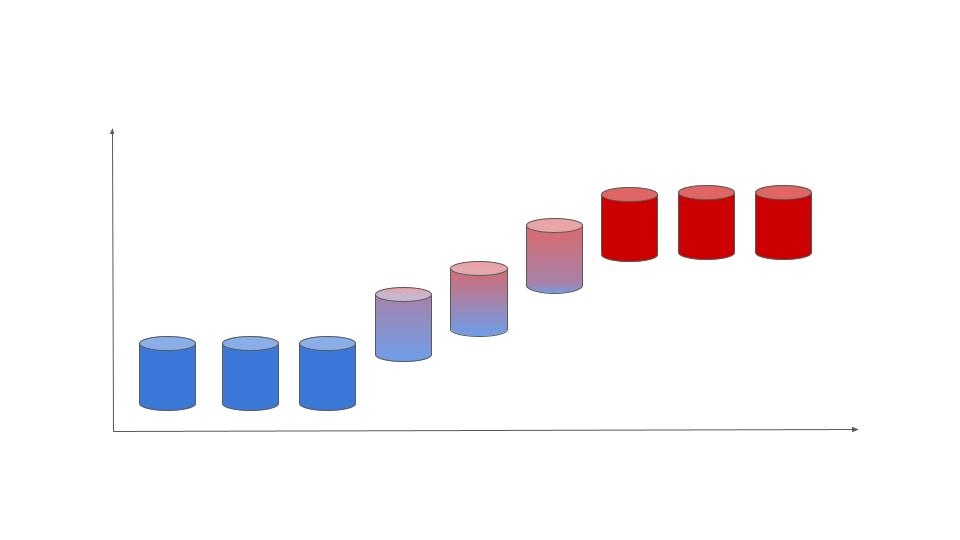Let’s take a look at the code for calculating some of the different Statistical distances, namely:
- Kolmogorov–Smirnov (KS)
- First Wassertein Distance (Earth Mover’s distance)
- Cramér-von Mises (CM) distance (Energy distance)
- Population Stability Index (PSI)
import pandas as pd
# Import Data File
data = pd.read_csv("data/rt_2563789698568873_gradual.csv")
data.head()
| X1 | X2 | class | |
|---|---|---|---|
| 0 | 0.550284 | 0.918541 | 0.0 |
| 1 | 0.564631 | 0.409379 | 0.0 |
| 2 | 0.430762 | 0.624576 | 0.0 |
| 3 | 0.662184 | 0.154598 | 0.0 |
| 4 | 0.266372 | 0.541274 | 1.0 |
data['class'].value_counts()
0.0 21219
1.0 19781
Name: class, dtype: int64
19781/data.shape[0]
0.4824634146341463
# Split Dataframe
def split_dataframe(df, chunk_size = 10000):
chunks = list()
num_chunks = len(df) // chunk_size + 1
for i in range(num_chunks):
chunks.append(df[i*chunk_size:(i+1)*chunk_size])
return chunks
def get_ratio(df, target_var='class'):
class_0_count = df[target_var].value_counts()[0]
class_1_count = df[target_var].value_counts()[1]
total_count = class_0_count+class_1_count
pos_ratio = class_1_count/total_count
return pos_ratio
data.shape
(41000, 3)
chunk_list = split_dataframe(data, 3418)
month_ = 1
for df in chunk_list:
df['month'] = month_
month_+=1
print(get_ratio(df))
0.4880046811000585
0.48244587478057344
0.4909303686366296
0.3317729666471621
0.32943241661790523
0.34991222937390287
0.6243417203042715
0.6146869514335869
0.609713282621416
0.489174956114687
0.4906377998829725
0.48853615520282184
data_monthly = pd.concat(chunk_list)
Mean Analysis
data_monthly_mean = data_monthly.groupby(by="month")[['X1','X2']].mean().T
data_monthly_mean.head()
| month | 1 | 2 | 3 | 4 | 5 | 6 | 7 | 8 | 9 | 10 | 11 | 12 |
|---|---|---|---|---|---|---|---|---|---|---|---|---|
| X1 | 0.507525 | 0.499226 | 0.494066 | 0.490010 | 0.503252 | 0.503267 | 0.499385 | 0.500954 | 0.499622 | 0.497465 | 0.490109 | 0.497236 |
| X2 | 0.499871 | 0.496975 | 0.500308 | 0.500965 | 0.494713 | 0.499834 | 0.494208 | 0.506740 | 0.500584 | 0.492279 | 0.492288 | 0.512654 |
2-sample Kolmogorov–Smirnov (KS) test
Since we are comparing the distributions, we need to set a reference distribution. This could be the first month of our dataset, or we could set the reference as the entire training dataset and then compare each month of the test set to the training set.
top_feature_list = ['X1','X2']
# Create reference dataframe
month_list = list(data_monthly['month'].unique())
d = {month: pd.DataFrame() for month in month_list}
for month in month_list:
d[month] = data_monthly[data_monthly['month']==month]
type(d)
dict
import numpy as np
from scipy.stats import wasserstein_distance, energy_distance, ks_2samp
#create an empty dataframe to store KS stats.
KS_stat=pd.DataFrame(columns=top_feature_list+['critical region'], index=month_list) #This dataframe has both the KS stat value and p value.
KS_stat2=pd.DataFrame(columns=top_feature_list+['critical region'], index=month_list) #This dataframe only has the KS stat value (not p value).
reference=d[1] #reference snapshot
n=reference.shape[0] #size of the reference distribution
for date in d.keys():
KS=[] #2-sample KS
KS2=[]
m=d[date].shape[0]
crit_reg=1.731*np.sqrt((n+m)/(n*m)) #critical region
for variable in d[date][top_feature_list]:
s,p=ks_2samp(reference[variable],d[date][variable])
KS.append(('stat: '+str(round(s,4)),'P: '+str(round(p,4))))
KS2.append(round(s,4))
KS_stat.loc[date]=KS+[crit_reg]
KS_stat2.loc[date]=KS2+[crit_reg]
/Users/numalj/.pyenv/versions/3.7.6/envs/general/lib/python3.7/site-packages/pandas/core/internals/blocks.py:993: VisibleDeprecationWarning: Creating an ndarray from ragged nested sequences (which is a list-or-tuple of lists-or-tuples-or ndarrays with different lengths or shapes) is deprecated. If you meant to do this, you must specify 'dtype=object' when creating the ndarray.
arr_value = np.array(value)
KS_stat
| X1 | X2 | critical region | |
|---|---|---|---|
| 1 | (stat: 0.0, P: 1.0) | (stat: 0.0, P: 1.0) | 0.041872 |
| 2 | (stat: 0.0243, P: 0.2659) | (stat: 0.0167, P: 0.7289) | 0.041872 |
| 3 | (stat: 0.0316, P: 0.0659) | (stat: 0.0123, P: 0.9587) | 0.041872 |
| 4 | (stat: 0.0342, P: 0.0364) | (stat: 0.0202, P: 0.4892) | 0.041872 |
| 5 | (stat: 0.0178, P: 0.6478) | (stat: 0.0161, P: 0.7682) | 0.041872 |
| 6 | (stat: 0.0138, P: 0.9032) | (stat: 0.0146, P: 0.858) | 0.041872 |
| 7 | (stat: 0.0184, P: 0.6071) | (stat: 0.0184, P: 0.6071) | 0.041872 |
| 8 | (stat: 0.0202, P: 0.4892) | (stat: 0.0199, P: 0.5082) | 0.041872 |
| 9 | (stat: 0.0211, P: 0.4343) | (stat: 0.0126, P: 0.9497) | 0.041872 |
| 10 | (stat: 0.0249, P: 0.2412) | (stat: 0.0301, P: 0.0897) | 0.041872 |
| 11 | (stat: 0.0298, P: 0.0953) | (stat: 0.0255, P: 0.2182) | 0.041872 |
| 12 | (stat: 0.0209, P: 0.4379) | (stat: 0.0291, P: 0.1073) | 0.041921 |
KS_stat2
| X1 | X2 | critical region | |
|---|---|---|---|
| 1 | 0.0 | 0.0 | 0.041872 |
| 2 | 0.0243 | 0.0167 | 0.041872 |
| 3 | 0.0316 | 0.0123 | 0.041872 |
| 4 | 0.0342 | 0.0202 | 0.041872 |
| 5 | 0.0178 | 0.0161 | 0.041872 |
| 6 | 0.0138 | 0.0146 | 0.041872 |
| 7 | 0.0184 | 0.0184 | 0.041872 |
| 8 | 0.0202 | 0.0199 | 0.041872 |
| 9 | 0.0211 | 0.0126 | 0.041872 |
| 10 | 0.0249 | 0.0301 | 0.041872 |
| 11 | 0.0298 | 0.0255 | 0.041872 |
| 12 | 0.0209 | 0.0291 | 0.041921 |
First Wassertein Distance
#create an empty dataframe to store first Wasserstein distance.
WD=pd.DataFrame(columns=top_feature_list, index=list(d.keys()))
reference=d[1] #reference snapshot
reference=reference.reset_index(drop=True) #the index should be reset, otherwise the algorithm does not work properly
for date in d.keys():
d[date]=d[date].reset_index(drop=True)
Wasserstein=[] #Wasserstein distance
#CM=[] # Cramér-von Mises distance
for variable in d[date][top_feature_list]:
#print(variable)
u_value=reference[variable]
v_value=d[date][variable]
#NaN values need to be removed, otherwise the returned value would be NaN
u_value = u_value[~np.isnan(u_value)]
v_value = v_value[~np.isnan(v_value)]
wd=wasserstein_distance(u_value,v_value)
Wasserstein.append(wd)
WD.loc[date]=Wasserstein
WD
| X1 | X2 | |
|---|---|---|
| 1 | 0.0 | 0.0 |
| 2 | 0.008514 | 0.006643 |
| 3 | 0.013466 | 0.003723 |
| 4 | 0.017525 | 0.00609 |
| 5 | 0.005132 | 0.006293 |
| 6 | 0.005379 | 0.00509 |
| 7 | 0.008252 | 0.006759 |
| 8 | 0.007993 | 0.007269 |
| 9 | 0.008308 | 0.003452 |
| 10 | 0.010128 | 0.009651 |
| 11 | 0.017424 | 0.008445 |
| 12 | 0.010295 | 0.012909 |
Cramér-von Mises (CM) distance (or Energy distance)
#create an empty dataframe to store Cramér-von Mises (CM) distance.
CM=pd.DataFrame(columns=top_feature_list, index=month_list)
reference=d[1] #reference snapshot
reference=reference.reset_index(drop=True) #the index should be reset, otherwise the algorithm does not work properly
for date in d.keys():
d[date]=d[date].reset_index(drop=True)
Cramer=[] # Cramér-von Mises distance
for variable in d[date][top_feature_list]:
u_value=reference[variable]
v_value=d[date][variable]
#NaN values need to be removed, otherwise the returned value would be NaN
u_value = u_value[~np.isnan(u_value)]
v_value = v_value[~np.isnan(v_value)]
cm=energy_distance(u_value,v_value)
Cramer.append(cm)
CM.loc[date]=Cramer
CM.T
| 1 | 2 | 3 | 4 | 5 | 6 | 7 | 8 | 9 | 10 | 11 | 12 | |
|---|---|---|---|---|---|---|---|---|---|---|---|---|
| X1 | 0.0 | 0.014657 | 0.021297 | 0.027419 | 0.009069 | 0.009011 | 0.013373 | 0.013767 | 0.013972 | 0.016237 | 0.026414 | 0.015571 |
| X2 | 0.0 | 0.010961 | 0.006421 | 0.010824 | 0.010467 | 0.008584 | 0.012049 | 0.012631 | 0.005941 | 0.017205 | 0.014662 | 0.020012 |
Population Stability Index (PSI)
import numpy as np
def calculate_psi(expected, actual, buckettype='bins', buckets=10, axis=0):
'''Calculate the PSI (population stability index) across all variables
Args:
expected: numpy matrix of original values (Training)
actual: numpy matrix of new values, same size as expected (Validation)
buckettype: type of strategy for creating buckets, bins splits into even splits, quantiles splits into quantile buckets
buckets: number of quantiles to use in bucketing variables
axis: axis by which variables are defined, 0 for vertical, 1 for horizontal
Returns:
psi_values: ndarray of psi values for each variable
Author:
Matthew Burke
github.com/mwburke
worksofchart.com
'''
def psi(expected_array, actual_array, buckets):
'''Calculate the PSI for a single variable
Args:
expected_array: numpy array of original values
actual_array: numpy array of new values, same size as expected
buckets: number of percentile ranges to bucket the values into
Returns:
psi_value: calculated PSI value
'''
def scale_range (input, min, max):
input += -(np.min(input))
input /= np.max(input) / (max - min)
input += min
return input
breakpoints = np.arange(0, buckets + 1) / (buckets) * 100
if buckettype == 'bins':
breakpoints = scale_range(breakpoints, np.min(expected_array), np.max(expected_array))
elif buckettype == 'quantiles':
breakpoints = np.stack([np.percentile(expected_array, b) for b in breakpoints])
expected_percents = np.histogram(expected_array, breakpoints)[0] / len(expected_array)
actual_percents = np.histogram(actual_array, breakpoints)[0] / len(actual_array)
def sub_psi(e_perc, a_perc):
'''Calculate the actual PSI value from comparing the values.
Update the actual value to a very small number if equal to zero
'''
if a_perc == 0:
a_perc = 0.0001
if e_perc == 0:
e_perc = 0.0001
value = (e_perc - a_perc) * np.log(e_perc / a_perc)
return(value)
psi_value = np.sum(sub_psi(expected_percents[i], actual_percents[i]) for i in range(0, len(expected_percents)))
return(psi_value)
if len(expected.shape) == 1:
psi_values = np.empty(len(expected.shape))
else:
psi_values = np.empty(expected.shape[axis])
for i in range(0, len(psi_values)):
if len(psi_values) == 1:
psi_values = psi(expected, actual, buckets)
elif axis == 0:
psi_values[i] = psi(expected[:,i], actual[:,i], buckets)
elif axis == 1:
psi_values[i] = psi(expected[i,:], actual[i,:], buckets)
return(psi_values)
## Calculate psi for top features
psi_list = []
for feature in top_feature_list:
# Assuming you have a validation and training set
psi_t = calculate_psi(df_validation[feature], df_training[feature])
psi_list.append(psi_t)
print(psi_t)

 Detecting Data Drift
Detecting Data Drift